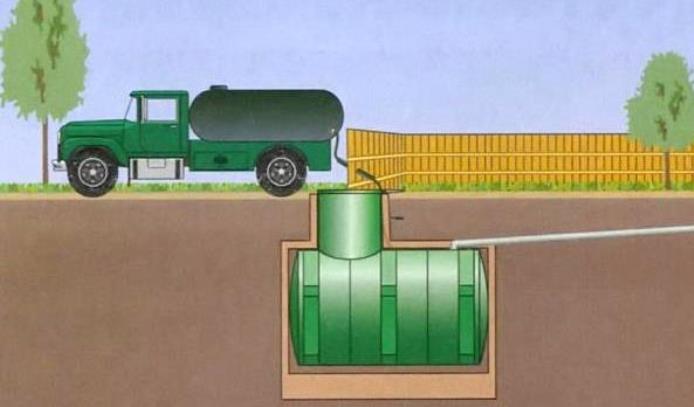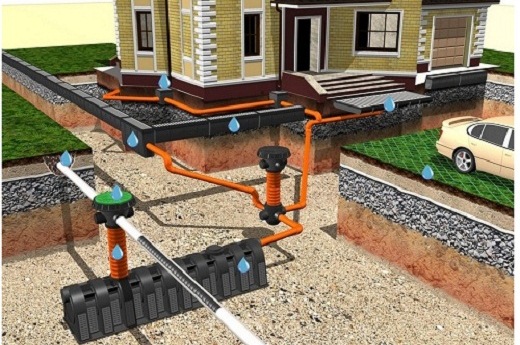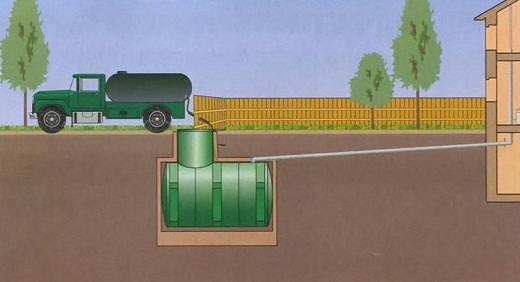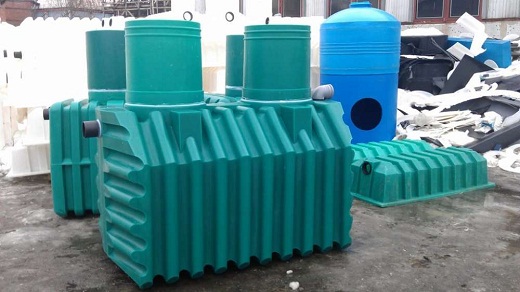Stock? What to choose for arranging an effective sewerage system country house? These questions are inevitable for homeowners. Of course, the final choice always depends on a variety of criteria, but it is at least inexpedient not to take into account the technical and operational features of VOC when choosing.
They ask: “What will happen if the electricity supply is cut off at the site?” The answer is simple, the VOC will continue to function, albeit not at full capacity. The drains will be clarified as in a flow-through septic tank, and as soon as the electricity supply is restored, the station will return to operating mode. Just think about it, but will you be able to fully use everything else in the house during a power outage? Shower? Washing machine? Of course not!
The high price of VOCs, compared to septic tanks, is not a serious drawback. During operation, the cost of such equipment quickly pays off. If you need a truly efficient drainage system, VOCs are your best bet.
Create in a country house comfortable conditions account for on their own: hot and cold water supply, heating, even light. But the main thing is the sewerage. Without thoughtful waste disposal, the presence of water on the site instead of comfort brings only problems. And if centralized system no, there is only one way out: to organize the treatment of domestic wastewater in your yard.
Today it is customary to call a septic tank any structure designed to purify domestic wastewater from organic impurities and mechanical impurities. There are many such systems, they all have their own names, differ from each other in the principle of operation and performance indicators. Strict ranking also complicates an integrated approach to the issues of clarification of sewage, since only it gives a satisfactory quality of water at the outlet.
Water in all devices goes through standard purification stages:
- Sedimentation - preliminary filtration, in which heavy impurities settle and accumulate at the bottom of the receiving tank.
- Fermentation - partial decomposition of organic matter by anaerobic bacteria occurs in the same or in the next chamber of the septic tank, where the effluents are separated into sludge and clarified water with the release of gases.
- Deep biological treatment - absorption and decomposition of organic compounds by aerobic microorganisms with a constant supply of oxygen (this stage may be absent).
- Mechanical filtration - the passage of effluents through the drainage layers.
The movement of water from one tank to another occurs through overflow pipes, gases are removed by fan ventilation, and sludge is removed approximately once a year through the upper hatches of the tanks. Regardless of the complexity and configuration of wastewater treatment systems, the principle of their operation is preserved.
How is it different from a cesspool. Advantages and disadvantages
The cesspool is an anachronism, the existence of which is justified only by primitiveness and cheapness. If its walls and bottom are not made airtight, harmful substances that you remove from the house will remain on the site. The pit is gradually filled with waste and regularly pumped out by vacuum trucks.
Septic tanks also need periodic cleaning, but not more than once a year. Unlike a pit, they do not accumulate waste, but partially process it and remove it.
A brief list of the advantages of active septic tanks is as follows:
- Site Biosecurity - Pollution Prevention ground water and fertile soil layers.
- No specific odor.
- Reducing the number of regular cleanings most of waste is recycled.
The disadvantage of a closed septic tank is the sensitivity of the colony of bacteria living in it to cleaning products used in everyday life. Chlorine and formaldehyde compounds, when released into the container, cause the death of microorganisms, and natural biological treatment is suspended.
What types are
Modern domestic septic tanks contain activated sludge - a sediment in which bacteria live and multiply. Inside the reservoirs, they do not appear on their own, but are “populated” artificially. The conditions necessary for their operation are determined by the type of microorganisms, and the classification of treatment facilities is also based on this.
Septic tanks with soil aftertreatment
Bacteria that decompose organic matter without the participation of oxygen live in anaerobic septic tanks. The fermentation that takes place inside the tank purifies the water by 50–60%, so it is necessary to remove the residues at least once a year. Plus, twice a month you need to “feed” anaerobes with bioactivators, such as Dr. Robik or Biosept. You don’t have to disassemble the receiving container for this - just flush a portion of the drug into the toilet.
Since the efficiency of oxygen-free decomposition is not high enough, it is recommended to use a two- or three-level system with post-treatment in the ground, consisting of separate chambers. The drain from the house is discharged into the first one, and the initial filtration takes place here: sediment falls to the bottom and is processed by anaerobic microorganisms, and the upper layers of water are poured through the pipe into the second tank. It already goes without a bottom and is installed on a filter pad in the ground, formed by layers of sand and gravel. Here, the undecomposed sediment lingers, and the liquid leaves.
Soil post-treatment is used only on well-filtering sandy and sandy loamy soils with low level water deposits. The effective bottom loading depth is 0.5–1.8 m.
For post-treatment, special facilities are installed:
- Well - recruited from iron concrete rings, brick, plastic or metal containers of sufficient rigidity. For a uniform distribution of wastewater, the spout of the pipe is taken out either to the center of the well, or is located above the water shield.
- The field is the same filter well, but horizontally oriented. The infiltrator cassette usually acts as a reservoir.
- trench - special case aeration field, involving the laying of drainage pipes.
The need to equip an aeration site is the main disadvantage of septic tanks. large-scale excavation, strict sanitary requirements and limitations in use on flooded soils do not allow us to call such systems universal. At the same time, their cost is quite high, and the efficiency, taking into account post-treatment in the soil, reaches 95–98%. Also, the pluses include ease of maintenance and non-volatility.
The aeration field increases the efficiency of the septic tank up to 95–98%
As an example of an anaerobic septic tank, we give a three-chamber model Tank. Here, the sewage processing chain is enclosed in a polypropylene case, and in each of the internal compartments, the water goes through its own purification path: it is fermented and settled. Autonomous system is already assembled and requires only installation in the pit and connection to the outlet pipes from the house. The final filtration takes place in the drainage field, which will have to be equipped separately.
Despite the tightness of the hull, it is recommended to locate the Tank with an adjoining post-treatment system 15 meters from residential buildings and sources of drinking water. It is also necessary to think over the entrance for the sewage truck, since it will have to be ordered annually. The lineup represented by four tanks with a volume of 1.2 to 3.6 cubic meters, designed for a family of 3-6 people.
Tank septic tanks are valued for their compact size, reliability and relatively low cost (from 20 to 50 thousand rubles), but the basic package does not include an infiltrating tank - it will have to be purchased separately, spending another 3-4 thousand. As an option, you can consider BioTank with cyclone filter where the colony of aerobes is settled. In this case, there is no need for a filtration field device, however, the cost of the septic tank also increases.
Aerobic septic tanks for deep biological treatment
Efficient local treatment systems (VOCs) separate up to 98% of contaminants from wastewater. This eliminates the need for frequent removal of non-decomposable sludge. There is also no need to include an additional filter tank in the drainage field in the design - aerobic bacteria perform its work. This is the main difference between VOCs and conventional septic tanks.

After clarification in VOC, water can be used for technical needs and watering plants.
However, for the decomposition of organic matter, microorganisms need oxygen, and it must be supplied continuously with the help of an installed compressor. As a result, the cost of a septic tank increases, and the volatility of such a system cannot be called a virtue. On the other hand, all the chambers through which water passes during the cleaning process are compactly located in one housing. This simplifies the installation of the system and allows you to place it even in a small suburban area.
The most effective is considered to be autonomous wastewater treatment, composed of a primary tank with anaerobic bacteria and post-treatment in a tank with an aerator and a biofilter. As a result, water is obtained at the outlet, corresponding in quality to technical water.
An example of an aerobic septic tank is Unilos Astra in a 2 cm thick polypropylene case, reinforced with stiffeners. Internal organization already more complicated than that of the Tank discussed above, although all the necessary cameras are also compactly placed in one case:
- Actually the septic tank, where the primary settling of water takes place.
- Aerotank with a connected compressor that supplies oxygen to the chamber for the operation of microorganisms.
- Sludge sump - here there is a division of the active medium by "age". Old heavy sludge goes to the receiver, from which it is subsequently removed, and young and light is returned to the aerotank.
- Settler for clarified wastewater - can be retrofitted with a pump. Also, the manufacturer optionally offers the installation of a disinfection unit.
Clarified water from one chamber to another is forcibly supplied - through airlifts. In the Unilos Astra database, designed to process 600 l / day (3 people), it costs 60-65 thousand rubles. sewer pumping unit will add another 20-25 thousand.
Bioreactors
SBR reactors differ from deep cleaning stations in that all processes in them take place in one chamber, but with a break in time. How this happens, consider the example of Topas septic tanks.
Within 4–12 hours, three cleaning operations are performed sequentially inside the bioreactor:
- effluent mixing and anaerobic digestion;
- settling;
- removal of sludge and clarified water.
The duration of the processes is controlled by the installed time relay and depends on the composition of the water at the inlet. On the one hand, this is convenient, on the other hand, the frequency of receipt of effluents is not taken into account. To keep the system running continuously, four SBRs would be required, with their duty cycles offset in time from each other.
Advantages of Topas bioreactors: compact dimensions and stable clarification rates, regardless of the volume and concentration of effluents at the inlet. Thanks to full cycle filtration will not have to look for a place in the area under the aeration field. Self-maintenance is also simplified, since there are very few residues in the bioreactor. The disadvantages include the high cost (from 80 thousand in the basic configuration) and the need to connect the system to the mains.
Criterias of choice
Choosing a ready-made septic tank or calculating performance homemade system, it is necessary to determine the intensity of the use of sewage. The total volume of tanks depends on the number of people and the seasonality of living in the house.
Capacity autonomous septic tank taken at the rate of 200 l / person per day. We multiply the result by 3 - this is how many days the effluents should settle according to sanitary standards. It is desirable to introduce a correction factor for the usable volume k = 1.3.
The characteristics of the soil on the site should also be inquired in advance, since installations with seepage wells will only work on light sandy and sandy loamy soils. The presence of a retaining clay layer or a high occurrence of water is already a reason to abandon septic tanks with the withdrawal of effluents for post-treatment. In this case, it is easier to purchase a more efficient VOC, from which water can be pumped into the nearest reservoir or used for technical needs.
When choosing the size of a septic tank or a local treatment station, the depth of soil freezing in a particular region is also taken into account - working tanks are installed below this mark. In the southern regions, it is better to take horizontally oriented tanks, vertical ones are used in areas where the soil freezes by 1.5–2 m.
For a private house with permanent residence
in the house with permanent residence and the sewer is used constantly, so it fills up quickly. To once again do not sponsor vacuum trucks, choose a plant with a minimum percentage of non-degradable residue. High-performance plants with bio-treatment and internal aeration are best suited for this. These are the "twins" Topas and Poplar, expensive systems such as FAST or budget Diamond.

Topas septic tank device
It is allowed to use septic tanks with the output of pre-clarified drains into the filtration field. But only if the site is large, and it is possible to locate the drainage away from buildings, wells and plantings. The height of groundwater and the composition of the soil, as mentioned above, are also taken into account. If the aquifers are closer than 2-2.5 m, you will have to return to the more expensive VOC option.
For giving
When Vacation home used only for seasonal living, there is no need for a complex cleaning system. In addition, without constant replenishment, microorganisms in the tanks of active septic tanks will die, and it will take two weeks and at least 1-1.5 thousand rubles to restore their colony. If the family lives in the country for one or two seasons, it makes sense to install a septic tank with additional treatment in the soil such as Terra-Praktik, Termite or the same Tank.
With rare and irregular arrivals, the choice is simplified - it is enough to connect the storage tank to the sewer and, as it fills up, release it from the contents. Just think about the installation location of the barrel so that the sewer truck can drive up to it.

The standard length of the hose on special equipment is 10 m, and the end of the pipe must reach the bottom of the tank
On average, a person produces 200 liters of household waste per day. Living in an urban environment, waste from human life processes calmly merge into the sewer. Not all country houses have a centralized sewage system, and wastewater needs to be diverted somewhere. About which septic tank to install only for summer residence. Any private home will also need a rainwater drainage system.
A septic tank is a well with a round or square section, in which water is purified by fermentation without oxygen. This system is non-volatile, that is, it does not require the use of electricity. With the help of a septic tank, water is purified by 65%.
Advantages of a septic tank:
- affordable price;
- no connection to the mains is required;
- long term services (with proper care;
- ease of operation;
- the possibility of retrofitting the system;
- solid reliable device.
Disadvantages of a septic tank:
- despite the rather low cost, during operation you will have to spend money on the regular call of special equipment for pumping;
- the presence of a characteristic odor is possible;
- restrictions on the installation of septic tanks (installation is not recommended in areas with an increased level of groundwater);
- low degree of purification of polluted water.
Storm water treatment plant or storm sewer consisting of pipes and water collectors. The main purpose of this system is to drain excess rain or melt water in order to protect the foundation of the house and to avoid the formation of large puddles on adjoining territory, including floods.

Advantages of storm sewers:
- the possibility of draining water not only from the roofs of houses, but also from roads and adjacent territories;
- protection of the foundation of the building;
- basement flood protection
- protection against moisture in rooms below ground level;
- protection of the local area from erosion and waterlogging;
Disadvantages of storm sewers:
- frequent clogging of pipes with leaves and sand;
- fast abrasion of some types of pipes.
Both of these types of sewers perform different functions, and it is not entirely advisable to compare them. Ideally, both of these systems should be installed on the site of a country house, so that both water falling from the sky and sewer do not cause trouble for residents.
What is better septic tank or cesspool?
About septic tanks, their disadvantages and advantages are described above. Consider the advantages and disadvantages cesspool and compare with a septic tank. About the advantages of a chamber septic tank in the country.
A cesspool is the simplest solution for wastewater disposal. A cesspool is a large well, usually without a bottom. A pipe was laid from the house to the pit, through which household waste flows by gravity.
Pit Benefits:
- one of the most simple species sewer systems for country houses;
- depending on the type of cesspool, the ability to do it yourself;
- affordable price;
- there is no need for frequent pumping of wastewater.
Disadvantages of a cesspool:
- no water purification system;
- if the cesspool does not have a sealed bottom, then all waste will fall into the ground, which pollutes the environment;
- such a system will not be able to cope with a large amount of daily waste;
- the need to regularly call special equipment to pump out the pit;
- characteristic odour.

If there is a choice between installing a septic tank or a cesspool, the following factors should be considered:
- the number of people living in the house;
- the total volume of water consumption in the house;
- financial opportunities.
If you don’t have much money, don’t visit a country house often, and your family consists of 3-4 people, then it’s quite possible to get by cesspool. The main thing is to prevent the overflow of the pit and monitor its timely pumping. If we consider sewer system in terms of ecology, convenience and long service life, it is better to choose a septic tank. Let its installation take a little more time and money, but in the future there will be much less hassle.
What is better septic tank "Tank" or concrete rings?

The photo shows a septic tank "Tank"
Septic Tank is a wastewater treatment device, has a polypropylene body. Water filtration in a septic tank is possible both mechanically and chemically.
Advantages of a septic tank Tank:
- robust system with thick walls;
- the design has an efficient overflow system and is very easy to install;
- long service life, more than 50 years;
- installation of a septic tank does not require cementing;
- waste is pumped out at least once a year;
- when using bacteria to treat wastewater, pumping can be done every 3-5 years.
Disadvantages of a septic tank Tank:
- cost, for some categories of citizens the cost is high;
- maintenance of a septic tank will also require regular expenses - either for pumping out solid waste, or for special additives, their cost depends on their effectiveness;
- the high-rise of groundwater matters, if groundwater comes close to the ground, then it is necessary to additionally strengthen the walls of the pit, otherwise the device will simply float in the spring;
- electricity connection required.
A septic tank made of concrete rings is a sewage treatment plant consisting of several reinforced concrete rings. Water purification in it occurs due to the fermentation of waste.

Advantages of a septic tank made of concrete rings:
Disadvantages of a septic tank made of concrete rings:
- a characteristic odor may appear;
- the regular need to pump out solid waste, which entails costs;
- possible leakage liquid waste into the soil if the joints of the rings are not well sealed;
- in areas with high level groundwater septic tanks from concrete rings are not installed.
What is better septic tank or biological treatment plant?
Station biological treatment. Wastewater treatment system by biological processes. Deep biological treatment occurs with the help of aerobic bacteria. Dirty waste water undergoes purification by 95-98% and the output is technical water and sludge. This system is volatile.
Advantages of the biological treatment plant:
- high degree of purification of polluted water;
- there is no need to dispose of the contents using special equipment;
- sufficiently long service life, up to 25 years;
- absence bad smell when used correctly;
- the installation of a treatment plant does not depend on the level of groundwater on the site.
Disadvantages of the biological treatment plant:
- rather high price;
- electricity connection is required, which in the future will entail additional costs for electricity.
If we compare all the pros and cons of a septic tank and biological station, then the latter has practically no disadvantages, only advantages. And the high cost will pay off all subsequent troubles associated with the maintenance and use of the treatment system.
Video
A variety of sewer organization for private use will allow you to choose a convenient and economical option. The video below describes the benefits of a Tank septic tank.
by the most expensive species treatment plants are the so-called deep cleaning septic tanks. Even despite their high cost, many owners of suburban real estate prefer them. What is the reason for such close attention to such installations? What is a deep cleaning septic tank in general, how does it work and is it worth trusting the advertising messages of manufacturers? We will talk about all this in our article.
Design of a deep biological treatment plant
All stations operating on a full cycle of wastewater treatment are aerobic septic tanks. Each installation has separate chambers (this is far from simple!), In which aeration installations are installed, which serve to saturate the effluents with atmospheric oxygen. Air is pumped into the aerators due to the operation of one or two compressors. Due to this, the effluents are enriched with oxygen, which contributes to the active reproduction of aerobic microorganisms.
Today, many models of deep cleaning septic tanks are produced, but? It is difficult to give an unambiguous answer to this question: when choosing, you need to be guided by the price / quality ratio, understand the design of the installations and the features of their work. For example, many manufacturers of septic tanks overestimate the values of volley discharges, not paying attention to the requirements for treated wastewater in the CIS.
As for the materials used for the production of deep cleaning stations, plastic is mainly used. best suited for long-term operation: it is sealed, does not corrode, relatively light, easy to maintain.
Advantages and disadvantages
Advantages of deep cleaning septic tanks:
- high efficiency of work - drains are cleaned by 98% of all harmful components;
- ease of installation and cleaning;
- compact dimensions;
- do not require the construction of a soil post-treatment site;
- no bad smell
Disadvantages of aerobic stations:
- volatility - and airlifts run on electricity;
- sensitivity to peak effluent discharges;
- designed for continuous operation;
- some components (compressors) fail after a few years of operation;
- high price
Be that as it may, the demand for septic tanks for deep biological wastewater treatment is constantly growing and more and more owners of suburban real estate are equipping a local sewage system based on them.








